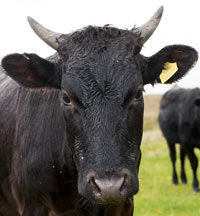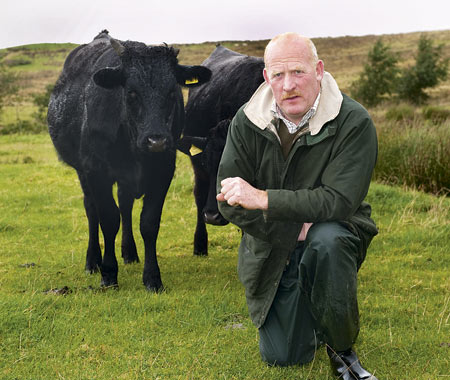Watch out for Wagyu in the UK

Selling purebred Wagyu fillet steaks for £120/kg may seem like a money spinner, but for Northumberland hill farmer Steve Ramshaw the breed has a lot more to offer.
He believes genetics from Wagyu beef, originally from Japan, could improve the value of beef-sired calves bred out of dairy cows.
“The Wagyu is a fascinating breed that has a future in the UK. But it isn’t going to be a breed that brings vast riches to beef producers just because of the value of the pure-bred beef.
“The breed has the potential to bring great improvements to the eating quality of beef. That’s where we see its primary role,” says Mr Ramshaw, who has about 20 Wagyu cattle on his 750-acre Monkridge Hill Farm, near Otterburn.
But, Mr Ramshaw is not a newcomer to championing quality beef in the UK. The farm carries a herd of Aberdeen Angus cows and it was his determination to improve the eating quality of his beef that inspired him to set up Northumbria Quality Meats 10 years ago.
“I was frustrated there were no means of measuring the eating quality and flavour of the beef we produce in the UK. There’s a mass of data covering all aspects of production and performance, but nothing that relates to the actual taste and texture of the meat.”

Driven by his determination to improve and sustain the eating quality of his Aberdeen Angus beef, Mr Ramshaw visited Canada to tour herds, talk to butchers, and to sample their beef. That led to the importation of Aberdeen Angus genetics with proven superior eating quality. But it also sparked an interest in the Wagyu cattle being farmed in Canada.
“Our first impression was that Wagyu is not a pretty breed; it’s ugly and wouldn’t impress any beef producer used to looking at what we all regard as good beef cattle in the UK. They don’t have the muscle structure we are used to seeing, but they have the ability to produce beef of superb eating quality.”
In Canada, he found the breed to be quiet and easy to handle, but he was aware because of the breed’s thin skin and placid nature it would need a different style of management to that used to rear cattle in the UK.
“You couldn’t out-winter these cattle and you couldn’t mix them with other breeds inside because they are so placid and they’d be bullied and prevented from feeding,” he says.
The breed is split into pure-breds and full-bloods. Pure-breds are considered to be about 99% pure, but have had an infusion of other breed genetics at some stage in their development. The full-bloods are 100% pure.
“The breed has poor maternal traits and isn’t very milky, so you’ve got to be careful about which bloodlines you get into,” he says.
Mr Ramshaw started by importing embryos from the USA as well as buying some younger cattle for finishing from an existing UK herd. The finishing cattle were summered outside and then housed for a two-month feeding period.
“The finishing ration was a good-quality grain-based diet of predominantly barley. The fat class was likely to be 4L when they were housed at 20 months old and weighing between 380kg and 400kg.”
The first steer has recently been slaughtered and produced a carcass weight of 340kg at fat class 05+. “The beef is superbly marbled with intramuscular fat and the meat grain is fine.”
The meat is hung for 28 days to achieve correct maturity and to enhance eating quality. Mr Ramshaw has also set up a marketing business to promote Wagyu beef and will soon have a website to sell the beef direct.
“Fillet steaks will cost £120/kg and sirloins £80/kg. Forequarter beef isn’t going to be a problem either because there’s a demand for Wagyu burgers. In the USA, a Wagyu burger costs about $45,” he says.
And Mr Ramshaw has a strong belief for the breed’s future in the UK. “There’s definitely a future for using Wagyu bulls on existing beef breeds to improve marbling and tenderness and we will be putting Wagyu on some of our Angus females. The dairy sector looks like being a potential market too if Wagyu genetics can produce beef animal with exceptional eating quality out of dairy cows.”
